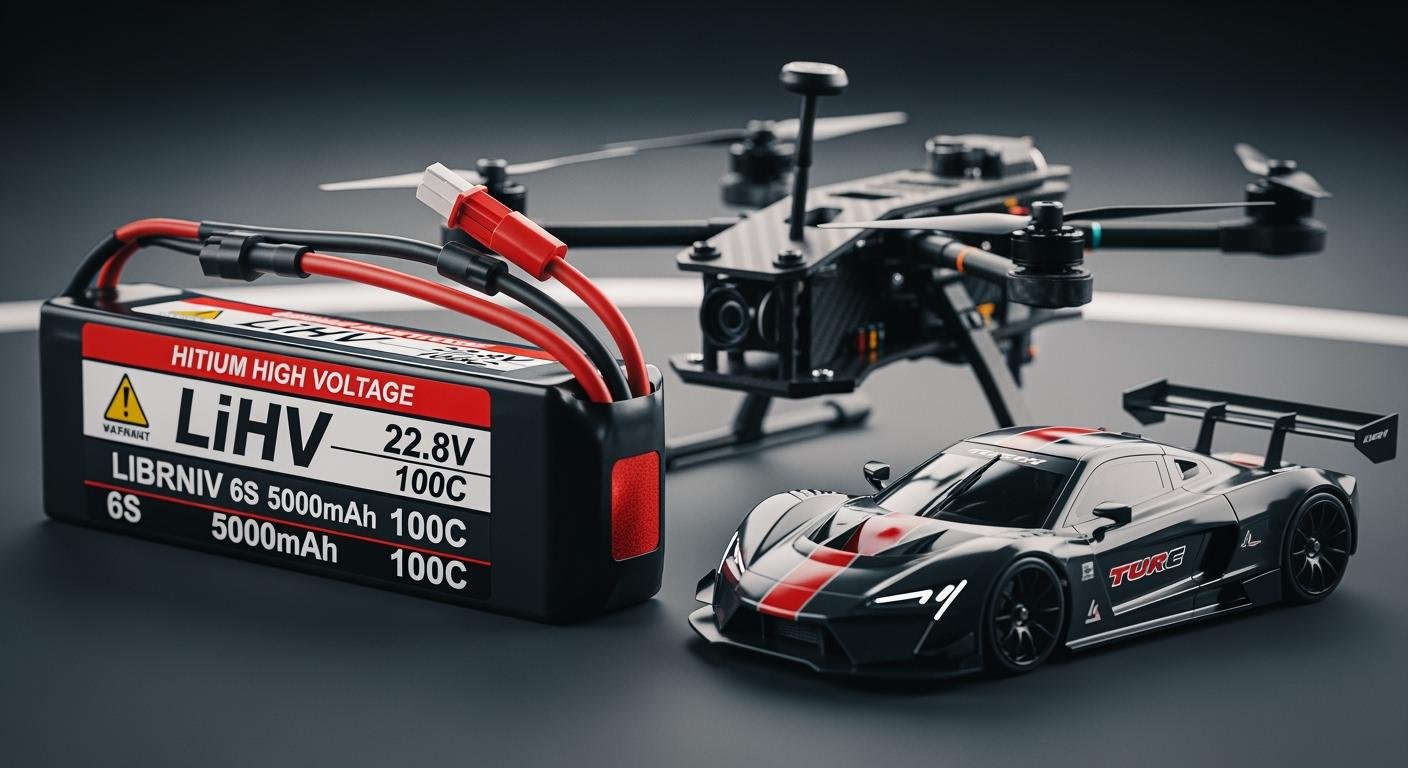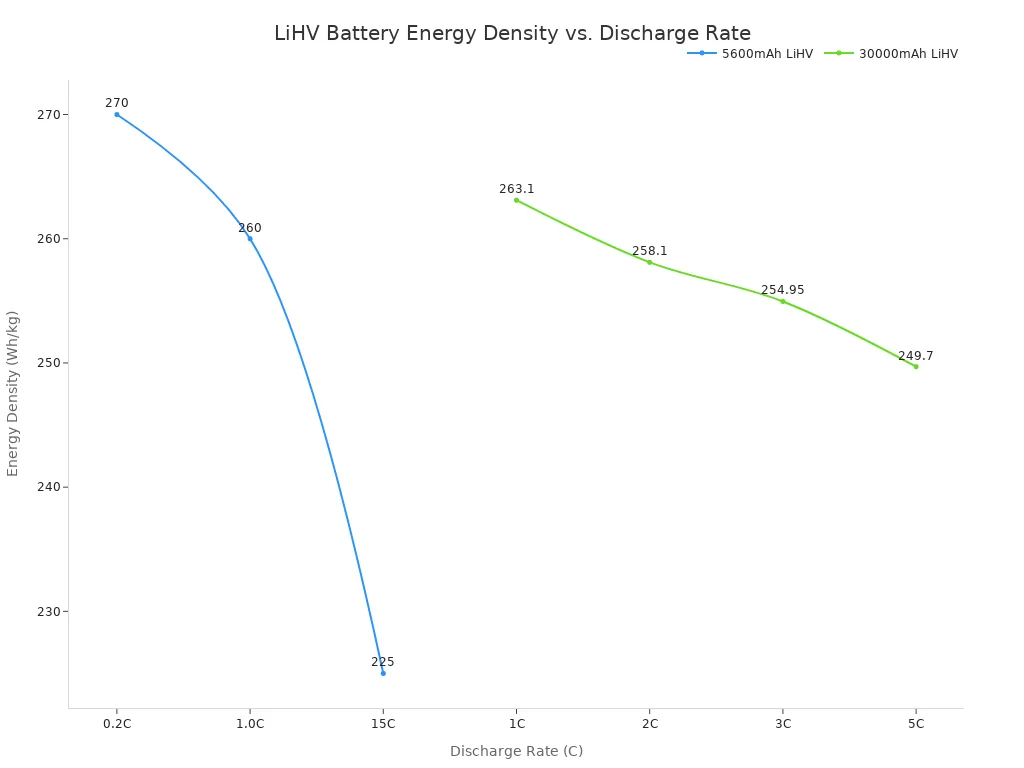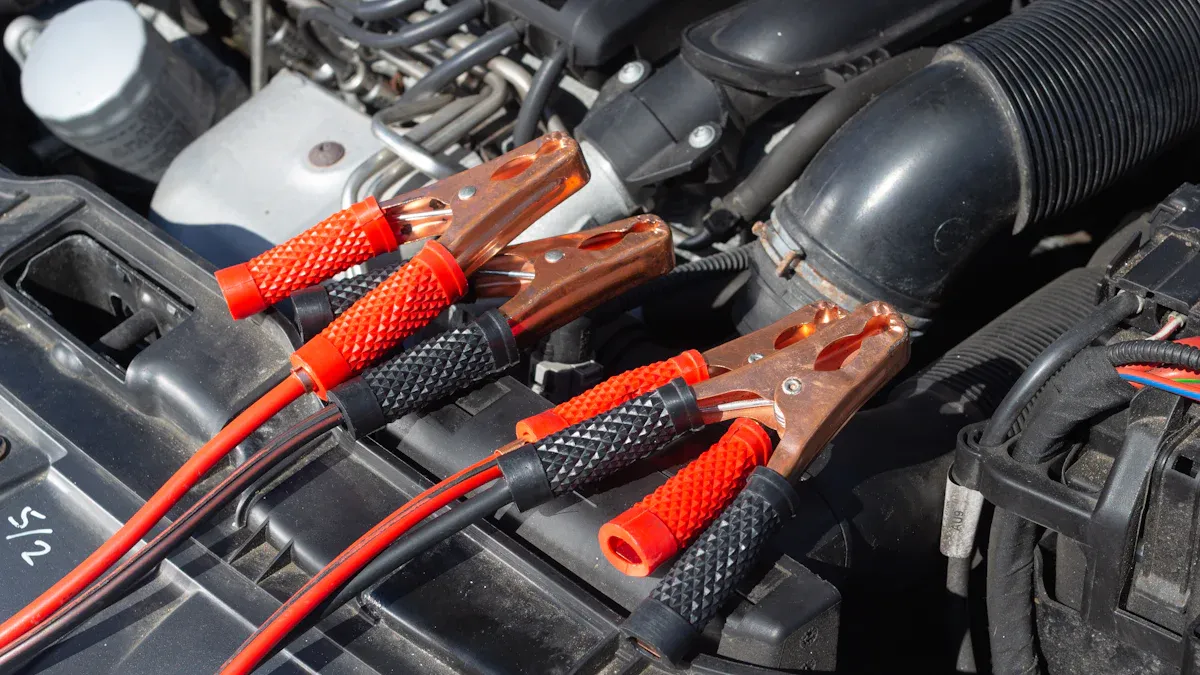
A LiHV battery is a high-voltage lithium-polymer battery. For your drone or RC vehicle, LiHV batteries offer a clear advantage: better performance. These LiHV batteries are popular with RC pilots seeking more power. The appeal of LiHV batteries for drones and RC is the potential for longer run times. Some LiHV batteries even claim a 10% capacity boost over standard lithium batteries of the same size. This high voltage battery can give your drone a serious edge. These powerful batteries are a great upgrade.
But are these LiHV batteries the right battery for your RC setup?
Understanding LiHV Batteries
You can understand LiHV batteries by looking at three key areas: their voltage, their energy storage, and their effect on performance. This technology offers clear benefits for your drone or RC vehicle. Let’s explore what makes these batteries unique.
The Core Voltage Difference
The main difference in LiHV batteries is their higher voltage. A standard lithium polymer (LiPo) battery cell charges to 4.20 volts. A LiHV battery cell charges to a higher 4.35 volts. This higher voltage is the foundation of their enhanced performance. This isn’t just a charging trick; it comes from the battery’s chemistry.
- LiHV batteries often use more cobalt in their chemical makeup.
- This specific technology allows the batteries to handle the higher voltage safely and remain stable.
This fundamental change in voltage is what unlocks the potential of LiHV technology for your RC hobby.
Higher Energy Density
LiHV batteries feature a higher energy density. This means they can store more power in the same amount of space compared to standard batteries. You get about 10-15% more capacity from LiHV batteries of the same physical size. This higher energy density technology makes your battery lighter without changing its shape. The high voltage output is a direct result of this improved energy density.
This chart shows how the energy density of LiHV batteries changes at different discharge rates.


The higher energy density in LiHV technology gives you more power without adding weight to your drone or RC car.
Performance Impact on Drones and RC
The higher voltage of a LiHV battery directly boosts your RC model’s performance. Your drone’s motors will spin faster because motor RPM increases with voltage. This gives you a noticeable increase in “punch” and acceleration. You can expect an overall performance gain of 8-10%. A fully charged 6S LiHV provides more initial power than a standard 6S LiPo. This means your drones and RC vehicles have more power right from the start, which is perfect for racing or demanding maneuvers. The advanced technology in these batteries translates to a real competitive edge.
LiHV vs. Standard LiPo

You know that LiHV batteries offer a performance boost. Now, let’s directly compare them to the standard LiPo batteries you might already use for your RC hobby. Understanding the differences helps you choose the right power source for your drone or RC vehicle. Both types of lithium batteries have their place, but their characteristics serve different goals.
Comparing the Batteries
The primary distinction between these two batteries is their voltage and chemistry. This core difference leads to changes in performance and how you handle the batteries. LiHV technology is an evolution of standard LiPo technology, designed for more power.
Here is a simple table to show you the main differences between the two types of batteries.
| Fonctionnalité | Standard LiPo | LiHV (High-Voltage LiPo) |
|---|---|---|
| Tension nominale | 3,7V par cellule | 3,8V par cellule |
| Tension de charge maximale | 4.20V per cell | 4.35V per cell |
| Densité énergétique | Standard | Higher (approx. 10-15% more) |
| Primary Appeal | Reliability and Longevity | Maximum Power and Performance |
The higher voltage of LiHV batteries gives your RC model a small but meaningful advantage right from the start.
Flight and Run Time
You can expect longer run times from LiHV batteries. The higher energy density means these batteries store more power in the same physical size. This extra capacity translates directly into more time in the air for your drone or more laps on the track for your RC car.
For high-demand RC racing, LiHV batteries are engineered to provide exceptional power output. This technology ensures your vehicle maintains optimal performance levels even under heavy use. The stable power delivery from a LiHV battery contributes directly to longer run times.
Advanced LiHV technology, like that found in Spec Silicon Graphene Lithium Polymer cells, improves internal resistance. This allows you to push your RC car to its limits with confidence. The combination of higher energy density and sustained power makes LiHV batteries a great choice for competitive events.
Cycle Life and Durability
Here is where you face a trade-off. While LiHV batteries provide superior performance, their lifespan can be shorter than standard LiPo batteries.
- Consistently charging LiHV batteries to their maximum 4.35V puts more stress on the battery’s internal chemistry.
- This stress can cause the battery to degrade faster over time.
- You might see a reduction in total charge cycles compared to a standard LiPo that is only charged to 4.20V.
This potential for faster aging is a key factor in battery longevity. If you prioritize getting the maximum number of uses from your batteries over peak performance, a standard LiPo might be a better fit. The higher voltage of the LiHV technology comes at the cost of some durability.
Weight and Size
One of the biggest advantages of LiHV technology is the improved energy density. This means you get more power without adding more weight. A LiHV battery will have roughly the same weight and size as a standard LiPo battery of the same cell count. This is a huge benefit for applications like drone racing and aerial photography, where every gram matters. You can upgrade your performance without needing to modify your drone or RC vehicle’s frame to accommodate a larger battery. This makes LiHV batteries an easy drop-in upgrade for many setups.
Key Applications for LiHV

You will find that certain applications benefit most from the unique advantages of LiHV batteries. These applications often prioritize maximum performance over the longest possible battery lifespan. For demanding tasks, the power from LiHV batteries provides a clear edge. Let’s explore the key applications where these batteries shine. These specific applications for remote-controlled vehicles are very popular.
FPV Drone Racing
In FPV drone racing, every millisecond counts. LiHV batteries give you a competitive advantage. The higher voltage directly translates to more power for your drone motors. These batteries are popular in many drone applications.
- You can charge LiHV batteries to 4.35V per cell, giving you more initial power than standard 4.20V batteries.
- This higher voltage gives your drone’s motors a performance boost, allowing for faster acceleration and more aggressive maneuvers.
- The greater energy density of LiHV batteries can also lead to slightly longer flight times, giving you more practice on the track.
These benefits make LiHV batteries a top choice for competitive FPV drone pilots. The high voltage output is a key factor in these applications.
Professional Aerial Photography
Professional unmanned aerial vehicles (UAV) often carry heavy payloads like high-resolution cameras and gimbals. LiHV batteries provide the extra power needed to lift this equipment while maintaining stable and agile flight. For professional drone applications, these batteries offer the necessary thrust for smooth cinematic shots. The improved performance ensures your drones can handle challenging wind conditions. Using LiHV batteries in these applications helps you capture high-quality footage without sacrificing flight time. These batteries are ideal for such applications.
High-Performance RC Vehicles
High-performance RC applications, like drag racing or speed run cars, demand instant power. LiHV batteries deliver the “punch” you need for rapid acceleration. These batteries support high discharge rates, providing stable power for your remote-controlled vehicles. This is crucial for quick bursts of speed to win races. The higher voltage makes the motors in your remote-controlled vehicles spin faster, leading to harder acceleration. Many professional RC racers choose LiHV for top performance in their remote-controlled vehicles. The power from these batteries helps you complete tough maneuvers and secure a win. For these RC applications, LiHV batteries are a game-changer. These batteries are perfect for your RC remote-controlled vehicles.
Compatibility and Safety
You can unlock the full potential of LiHV batteries when you prioritize compatibility and safety. The higher voltage that gives your RC model its edge also requires special equipment and careful handling. Following the correct protocols ensures you enjoy the performance boost without risking damage to your gear.
The Essential LiHV Charger
You cannot use a standard LiPo charger for LiHV batteries. You need a charger specifically designed for the higher voltage of a LiHV battery. A proper charger is the most important safety tool for your batteries.
Look for these features on a charger to confirm it supports LiHV:
- Hi-Voltage LiHV Mode: The charger must have a dedicated charging mode for LiHV batteries that allows charging up to 4.35V per cell.
- Multi-Chemistry Support: The product description should explicitly list “LiHV” as a supported lithium battery type.
- Adjustable Terminate Voltage: It allows you to set the final cell voltage to 4.35V for your LiHV batteries.
ESC and Motor Voltage Limits
Before you connect a new LiHV battery, you must check your drone or RC vehicle’s hardware limits. The higher voltage from LiHV batteries can damage components not rated for it. An ESC (Electronic Speed Controller) has a maximum voltage rating. For example, some are rated for 3S-4S batteries, while others handle 6S.
A fully charged 6S LiHV battery reaches 26.1V, which is higher than a standard 6S LiPo’s 25.2V. Always do the math to ensure your ESC and motors can handle the power from LiHV batteries.
Charging Your LiHV Battery
Proper charging is critical for the performance and safety of your batteries. Fast charging is possible, but you must follow a strict procedure.
- Inspect First: Before charging, check your battery for any damage like swelling or dents. Place it in a LiPo safety bag away from flammable items.
- Set the Charger: Select the “LiHV” charging mode. Set the correct cell count and a safe charge rate (1C is standard).
- Connect Carefully: Connect the main power leads, then the balance lead. The charger should show you the voltage of each cell.
- Monitor Charging: Never leave charging batteries unattended. If you see excessive heat or swelling, stop the charging process immediately.
- Disconnect Safely: Once charging is complete, disconnect the balance lead first, then the main power leads.
This careful charging routine protects your investment in high-performance LiHV batteries.
Storage and Handling Protocols
How you store your batteries is just as important as how you use them. For long-term health, you should not leave your LiHV batteries fully charged for more than a day or two.
The correct storage voltage for both standard lithium and LiHV batteries is 3,8V par cellule. After a session with your drone or RC car, use your charger’s “Storage” function. This brings the batteries to a safe level, reducing stress on the cells and extending their lifespan. When transporting your batteries, protect the terminals to prevent short circuits. This simple step is a key part of RC safety.
LiHV batteries give your RC drone more power and potential for longer run times. These LiHV batteries are powerful batteries for your RC drones. Remember the trade-offs for these LiHV batteries. You need a special charger for your LiHV battery. The overall life of these batteries can be shorter. LiHV batteries are excellent batteries for your RC needs.
For your RC drone, LiHV batteries are a top choice for performance. If you want a longer-lasting battery for your RC, standard batteries are a solid option. Your LiHV battery offers longer run times, making LiHV a great upgrade for many RC pilots.
FAQ
Can I use my old charger for new LiHV batteries?
No, you must use a specific charger for your LiHV batteries. Standard chargers for lithium batteries stop at 4.20V. Your LiHV batteries need a charger with a LiHV mode. This mode provides the higher voltage of 4.35V. Using the wrong charger on these batteries is unsafe.
What happens if I charge LiHV batteries to only 4.20V?
You can charge your LiHV batteries to 4.20V. This makes the LiHV battery act like a standard LiPo battery. You will not get the higher voltage performance boost from these batteries. However, this practice can extend the cycle life of your LiHV batteries, making the batteries last longer.
Are LiHV batteries safe for every RC model?
You must check your RC model’s compatibility. The higher voltage from LiHV batteries can damage electronics. Your RC vehicle’s ESC and motors must handle the higher voltage. Always review the specifications for your RC components before using these powerful batteries. Many batteries are not universal.
Important Note: A fully charged 6S LiHV battery has a higher voltage than a standard 6S LiPo battery. This difference can damage an RC system not rated for these batteries. Check your gear to protect your batteries and your RC model. These batteries require care.
Why do LiHV batteries have a shorter lifespan?
The higher voltage puts more stress on the internal chemistry of the LiHV battery. Consistently charging these batteries to their maximum 4.35V causes them to degrade faster than standard lithium batteries. This trade-off gives you more power from the batteries but fewer total charge cycles for the battery.

